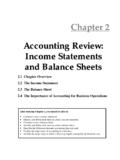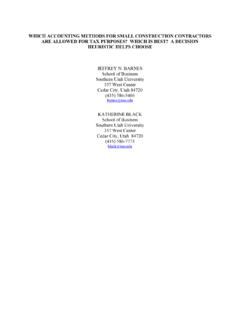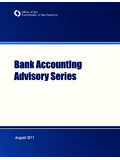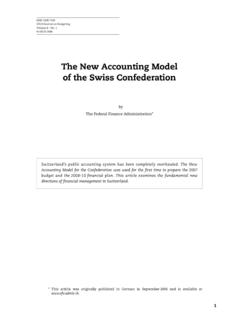Transcription of ACCOUNTING STANDARDS FOR PRIVATE ENTERPRISES …
1 ACCOUNTING STANDARDS FOR PRIVATE ENTERPRISES ( ASPE ) CA MAGAZINE By Allan Foerster + Mark Walsh Illustration: Gary Sawyer ASPE comes into effect for years beginning on or after January 1, 2011 after that date the existing Handbook STANDARDS (now found in Part V of the Handbook) will no longer be Canadian GAAP for either publicly accountable ENTERPRISES or PRIVATE ENTERPRISES . PRIVATE ENTERPRISES can adopt ASPE prior to 2011. In deciding whether to early adopt, a PRIVATE enterprise should consider factors such as the benefits of the ACCOUNTING simplifications and reductions in disclosures discussed below and the amount of change required to ACCOUNTING processes and systems. After a process that began in 2006 with the recognition that one size does not necessarily fit all, the ACCOUNTING STANDARDS Board (AcSB) issued ACCOUNTING STANDARDS for PRIVATE ENTERPRISES (ASPE) in December 2009.
2 They can be found in Part II of the CICA Handbook ACCOUNTING . What do these new STANDARDS mean for PRIVATE ENTERPRISES and their professional advisers? What are the key changes? When do they have to be applied? With ASPE, most of the practices and policies used by PRIVATE ENTERPRISES won't change. There will be differences in key areas though. The new STANDARDS are designed to take into account both costs to preparers and benefits to users of the financial statements. In most cases it will be obvious if an enterprise is PRIVATE or not, but those that are unclear should refer to the definitions in the preface to the Handbook. Most PRIVATE ENTERPRISES will use ASPE, but they can choose IFRS instead. Most PRIVATE ENTERPRISES will find ASPE less onerous than IFRS.
3 If a PRIVATE enterprise chooses IFRS, they must adopt all IFRS, which may result in many more differences from their current reporting and significantly higher training and conversion costs than ASPE. Also, when IFRS is chosen, there will no longer be differential reporting options such as taxes payable, cost method for subsidiaries and equity classification of redeemable preferred shares issued as part of a tax-planning strategy. Circumstances that may make adopting IFRS attractive include: plans to do an IPO, which will require IFRS reporting potential debt or equity financing from foreign sources that do business using IFRS main competitors are public ENTERPRISES and using IFRS will facilitate comparisons parent company uses IFRS lenders and other users require use of IFRS Eight Key Differences From Existing STANDARDS ASPE was developed from the existing Canadian ACCOUNTING STANDARDS .
4 This means that most of the ACCOUNTING policies and practices used by PRIVATE ENTERPRISES will not change. The changes are focused on those areas that have caused the most difficulties for PRIVATE ENTERPRISES . This should make learning about, understanding and adopting ASPE much easier than, for instance, IFRS. 1. Disclosures The disclosure requirements in the existing Handbook are often seen as focusing on the needs of investors in public companies, and as excessive and costly for PRIVATE ENTERPRISES . In developing the disclosures in ASPE, key considerations were the needs of users of PRIVATE enterprise financial statements (primarily lenders) and the effort and cost involved for preparers. The result was the elimination or simplification of a considerable number of disclosure requirements.
5 One significant disclosure has been added: the disclosure of the amount payable at the end of the period in respect of government remittances, other than income taxes. Lenders see this as important information as these amounts usually have priority status in a bankruptcy. A new feature of ASPE is the provision of a compilation of disclosures that brings them together in one place. This is not intended as a checklist of disclosures. Indeed, the compilation notes that, in some circumstances, additional disclosures might be required for fair presentation. It also notes that disclosure of information that is not material to the financial statements is not required. The amount of reduction in disclosures will vary from company to company depending on the type of transactions and the complexity of the business.
6 Overall, the reduction in disclosures resulting from focusing on the needs of PRIVATE ENTERPRISES is expected to be significant. 2. EIC abstracts Over the years the Emerging Issues Committee (EIC) abstracts have grown to be a substantial part of Canadian GAAP. Some viewed them as helpful while others disagreed with one or more abstracts or found them burdensome. ASPE does not include the EIC abstracts. However, some material from 29 of the abstracts has been incorporated into the relevant STANDARDS so as to improve the guidance in those STANDARDS . One of these abstracts is EIC-122, which addresses the balance sheet classification of callable debt and debt obligations expected to be refinanced. The requirements of EIC-122 have been included in Section 1510, Current Assets and Current Liabilities, together with an example of a presentation format that clarifies the nature of callable debt classified as a current liability.
7 The result of not including the EIC abstracts is that ASPE is, in some areas, less prescriptive than the current STANDARDS . However, guidance in the abstracts that has not been carried forward, while not required to be applied, will generally remain an appropriate ACCOUNTING choice for PRIVATE ENTERPRISES . This may not be true when changes have been made to a section of the Handbook that affects the issue addressed in the abstract. 3. Financial instruments Many PRIVATE ENTERPRISES have been using the XFI Handbook, which contains relatively little guidance on financial instruments. Other PRIVATE ENTERPRISES have adopted the financial instruments STANDARDS in the current Handbook. ASPE has consolidated all the financial instruments requirements into a single standard Section 3856, Financial Instruments.
8 The impact of this new standard will vary depending on whether or not the XFI Handbook has been used in the past. Some key elements of the financial instruments STANDARDS are: Most financial instruments may be measured at historical cost. Any premium or discount is amortized over the expected life of the item and recognized in net income as interest income or expense. The method of amortization is not specified. Only equity instruments traded in an active market and freestanding derivatives must be measured at fair value. (Derivatives that are part of a hedging relationship and certain other derivatives may be measured at cost.) However, a PRIVATE enterprise can choose to measure one or more of its other financial instruments at fair value if it so wishes.
9 This choice must be made when the financial instrument is first recorded and cannot be changed subsequently. Any gain or loss resulting from the use of fair value is recorded directly in income. Transaction costs are capitalized as part of the cost of a financial instrument unless it is measured at fair value, in which case the costs are recognized as an expense. There is a single impairment model for all financial assets that compares the recorded amount of the instrument to the higher of the amounts recoverable by holding the asset, selling it or realizing any security. Impairment losses for a financial asset in one period must be reversed if its recoverable amount increases in a subsequent period. Compound financial instruments possessing both a debt and equity component will have to be bifurcated.
10 However a PRIVATE enterprise may choose to measure the equity component at a zero value. The situations where hedge ACCOUNTING may be used have been restricted to those that are most common for PRIVATE ENTERPRISES such as hedges of an anticipated purchase or sale of a commodity or of an anticipated transaction denominated in a foreign currency; interest rate swaps; cross-currency interest rate swaps; and hedges of net investments in a self-sustaining foreign operation. This narrower focus has permitted simplification of the hedge ACCOUNTING process. Redeemable preferred shares issued as part of a tax-planning strategy must be recognized in equity until a demand for payment is made, at which time the shares will be reflected as debt.





